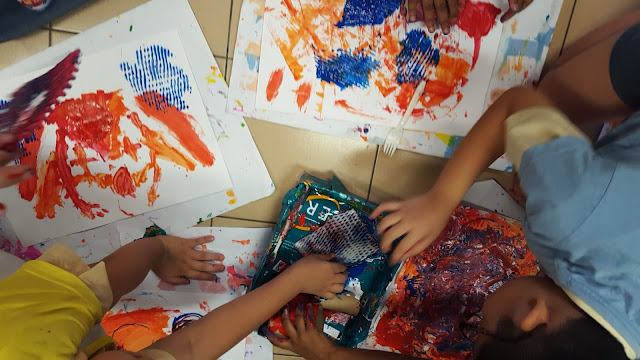Welcome to a new tab of 'Reads'! This column will serve to record at least a learning point from the books that I've read. These books could be related to the arts or education or anything in between.
My friend, T, recommended this book. The father and daughter team co-wrote a book that's really easy on the eyes. The layout of the book is such that the left side of a spread is always a summary of the content on its right. The summary consists of mainly bullet points, graphics and bolder fonts.
The above image of a cycle caught my eyes because my school is big on growth mindset and this graphic is like an extension of the growth mindset for adults. Young children are naturally curious and learning is innate. I think a teacher's role is to channel these curiosities into meaningful ventures. Sometimes, I observed a curious child staring intently at something that caught her/ his interest and the reactions from the accompanied adults. The desire of knowing is so intense that I wonder if adults can sustain that comparable amount of that curiosity.
That said, learning for adults usually comes with knowing the purpose. I think it's either a push or pull factor. Since people have learnt to be pragmatic, most people have learnt to weigh inputs and outputs. What good would it do to do something that only a few see the benefit in? A transactional mindset. You do something, you expect results. If the results exceed the inputs then it's a bonus. If that bonus results from chance, an accident, then perhaps more effort is invested to see if that bonus can be replicated. If so, it becomes a formula.
Someone told us that as teachers, we can never be paid enough for what we do. That is true. In the above diagram, I think the most unfortunately domain to reside in is 'unconscious incompetence'. My own interpretation of that is you don't know what you do not know (yet). I guess the point about learning is gradually uncovering what you do not really know yet and not repeating formulas.
In a way, learning is to a large extent associated with self-awareness. Nobody can force you to learn something if you are not keen in mastering a skill. How you learn a skill is also important. For example, it could be self-taught or from someone that you are keen to hear from. Next, to enable learning is to disable ego. To dissipate judgement, fear and ego meant that learning can be achieved in a peaceful manner.
 |
| Taken from: Winning With Honour by Lim Siong Guan & Joanne Lim, pg. 358 |
The above image of a cycle caught my eyes because my school is big on growth mindset and this graphic is like an extension of the growth mindset for adults. Young children are naturally curious and learning is innate. I think a teacher's role is to channel these curiosities into meaningful ventures. Sometimes, I observed a curious child staring intently at something that caught her/ his interest and the reactions from the accompanied adults. The desire of knowing is so intense that I wonder if adults can sustain that comparable amount of that curiosity.
That said, learning for adults usually comes with knowing the purpose. I think it's either a push or pull factor. Since people have learnt to be pragmatic, most people have learnt to weigh inputs and outputs. What good would it do to do something that only a few see the benefit in? A transactional mindset. You do something, you expect results. If the results exceed the inputs then it's a bonus. If that bonus results from chance, an accident, then perhaps more effort is invested to see if that bonus can be replicated. If so, it becomes a formula.
Someone told us that as teachers, we can never be paid enough for what we do. That is true. In the above diagram, I think the most unfortunately domain to reside in is 'unconscious incompetence'. My own interpretation of that is you don't know what you do not know (yet). I guess the point about learning is gradually uncovering what you do not really know yet and not repeating formulas.
In a way, learning is to a large extent associated with self-awareness. Nobody can force you to learn something if you are not keen in mastering a skill. How you learn a skill is also important. For example, it could be self-taught or from someone that you are keen to hear from. Next, to enable learning is to disable ego. To dissipate judgement, fear and ego meant that learning can be achieved in a peaceful manner.




















